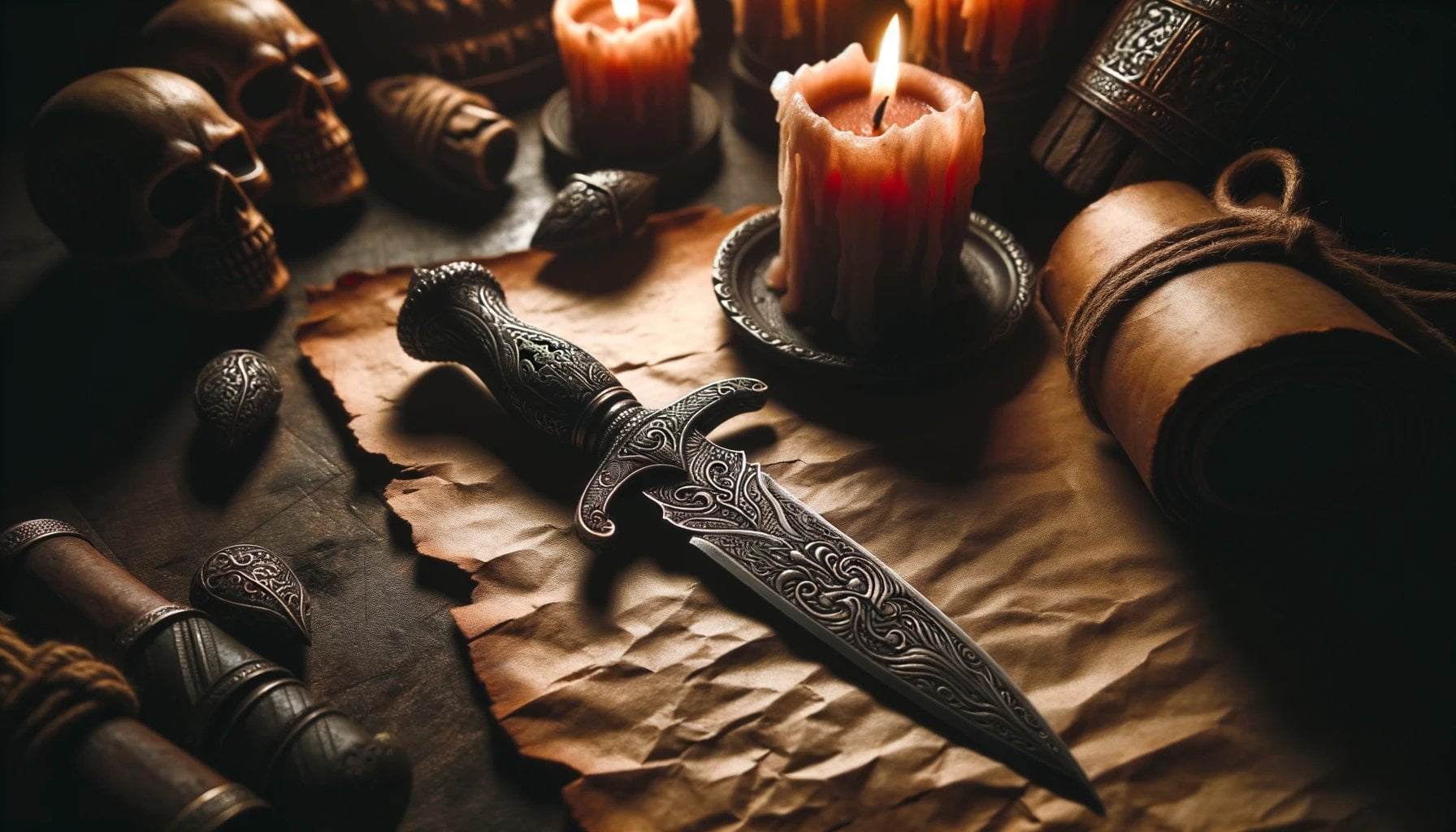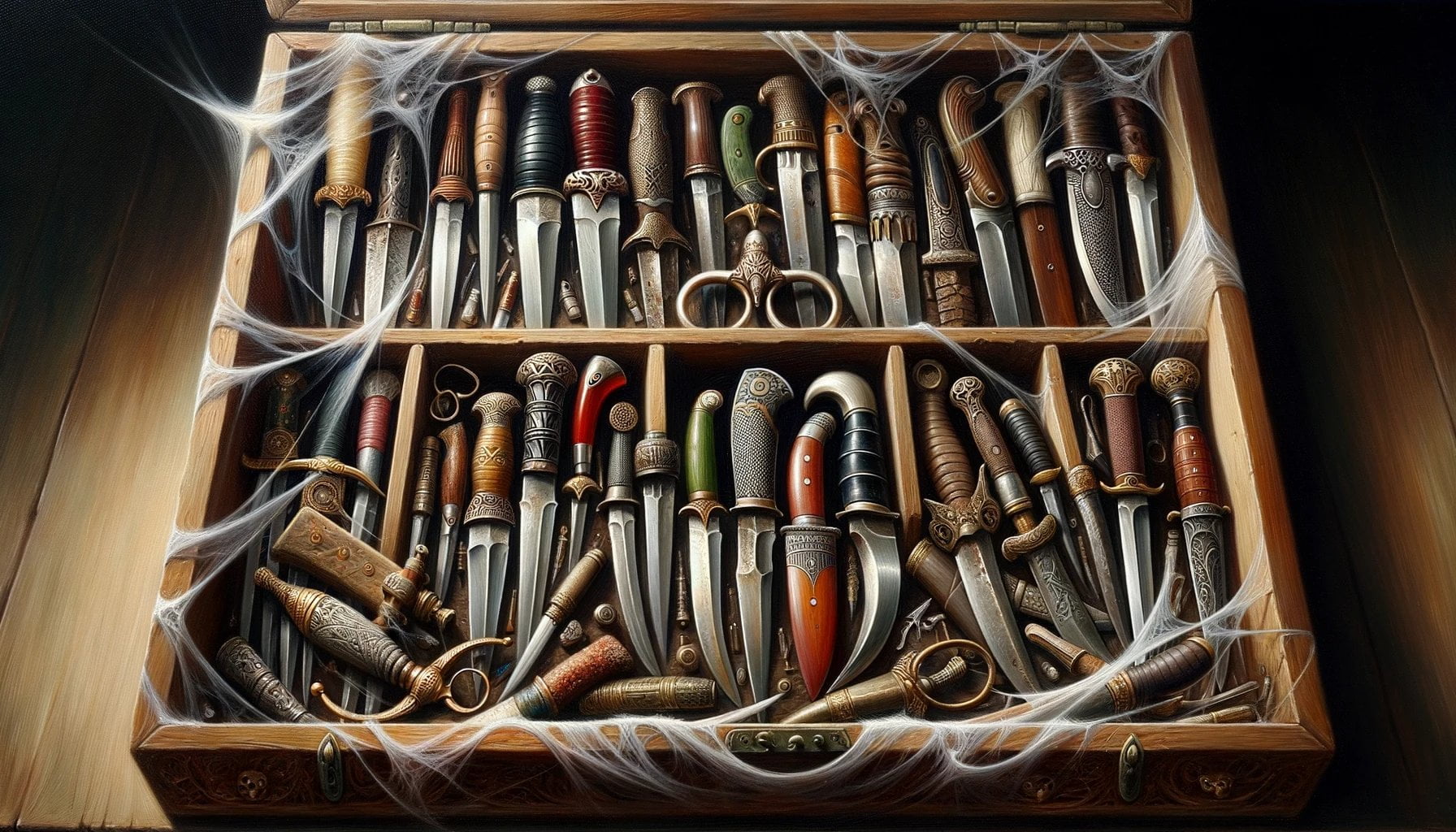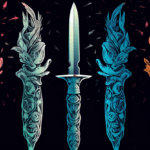Discover the secrets hidden within ancient daggers as our expert archaeologist embarks on a journey to unravel their mysteries. In this captivating exploration, we delve into the world of ancient Egyptian, Greek, and Chinese daggers, uncovering their historical significance and shedding light on their cultural and functional roles. With a decade of fieldwork and research, our knowledgeable archaeologist brings a keen eye for detail and a deep understanding of historical contexts, offering insightful perspectives on the craftsmanship, symbolism, and usage of these fascinating artifacts. Join us as we embark on this fascinating archaeological quest: Unraveling Ancient Dagger Mysteries: Expert Archaeologist Sheds Light.

Ancient Daggers
Early Origins and Evolution
The fascinating world of ancient daggers holds countless mysteries waiting to be unraveled. These weapons, often associated with valor and power, have a rich historical significance that goes far beyond their practicality. Let’s delve into the origins and evolution of ancient daggers to gain a deeper understanding of their cultural and functional roles.
Neolithic Times and the Birth of Daggers
Our journey begins in the Neolithic times, where the earliest known daggers were crafted from simple materials such as flint, ivory, or bone. These primitive but effective weapons served as tools for hunting and self-defense. Their jagged edges ensured that they could pierce through flesh and hide, making them invaluable companions for early humans navigating a harsh and dangerous world.
The Bronze Age and the Rise of Copper Daggers
As civilizations advanced and metalworking techniques evolved, the Bronze Age brought about a significant shift in dagger craftsmanship. Copper daggers emerged as a symbol of progress, marking a crucial milestone in human innovation. These daggers, dating back to the 3rd millennium BC, showcased the mastery of early artisans and their ability to harness the durability and versatility of copper.
Unearthing Ancient Dagger Secrets
One remarkable discovery shedding light on the historical significance of daggers comes from Knossos, a site in Crete. Archaeologists excavating the area unearthed copper daggers from the Early Minoan III period (2400–2000 BC). These artifacts offer a glimpse into the Minoan civilization’s culture, revealing the importance of daggers both as weapons and symbolic objects in ceremonies.
Functionality Redefined: From Ceremonial to Utilitarian
A fascinating revelation in the study of ancient daggers is the evidence challenging previous beliefs about their function. Prehistoric daggers that were long thought to be non-functional ceremonial objects have been found to have a practical purpose. Analysis of wear patterns and residues revealed that these seemingly ornamental daggers were actually used for slaughtering and butchering animals. This revelation provides invaluable insights into the daily lives and practices of our ancient ancestors.
Daggers Across the World: From China to Europe
Moving beyond the Mediterranean, let us explore the diverse array of daggers found in different cultural traditions. In China, the dagger-axe, with its distinctive shape resembling a combination of a dagger and an axe, holds great historical significance. These daggers were not only backup weapons but also played important ceremonial roles in rituals and traditions.
In Europe, during the 5th to 3rd century BC, iron daggers became prominent. Skilled artisans and blacksmiths in Iberia produced these finely crafted weapons, adding an impressive chapter to the story of ancient daggers. These iron daggers showcased the artistry and expertise of these craftsmen while serving as potent tools on the battlefield.
The Roman Empire and the Pugio
As we journey through time, we cannot ignore the remarkable influence of the Roman Empire. Roman legionaries were issued the pugio, a double-edged iron thrusting dagger. This weapon exemplified the Roman military’s efficiency and strategic prowess. The pugio’s design and functionality reflected the disciplined and meticulous nature of the legions, underscoring the Romans’ commitment to achieving victory.
Expanding Horizons: Daggers in Different Cultures
Daggers, with their wide array of shapes, materials, and cultural significance, have permeated various regions of the world. From the European, Asian, African to American cultural traditions, these weapons have played a pivotal role in shaping history and reflecting the diverse beliefs and practices of civilizations throughout the ages.
In conclusion, the study of ancient daggers unveils a tapestry of historical narratives and cultural nuances. By meticulously analyzing these artifacts, archaeologists specializing in ancient weaponry like myself can shed light on the craftsmanship, symbolism, and usage of ancient daggers. Through their intricate details, we are transported back in time, gaining a deeper appreciation for the ingenuity and creativity of our ancient predecessors. Ancient daggers continue to captivate scholars and enthusiasts alike, allowing us to connect with the past and understand the stories etched into these fascinating relics of bygone eras.
Ancient daggers have a rich and fascinating history. From the first dagger ever created in history to the preferred weapon of knights, these deadly blades have intrigued us for centuries. But did you know that Vikings also relied heavily on daggers? Find out more about the Vikings’ use of daggers and their significance in their warrior culture: Did Vikings use daggers?
Yemenis have a long-standing tradition of carrying daggers, and it’s not just for self-defense. Discover the cultural and symbolic reasons why Yemenis carry daggers and delve into the fascinating world of Yemeni traditions: Why do Yemenis carry daggers?
The ancient Egyptians were known for their mastery of many crafts, including the production of intricate and beautiful daggers. Uncover the secrets of Egyptian craftsmanship and explore the daggers that played a role in their society: Did Egyptians have daggers?
If you’re curious about the different types of daggers, you might be wondering if a dirk is considered a dagger. Delve into the world of daggers and discover the distinctions between these two blade varieties: Is a dirk a dagger?
When it comes to historical weapons, the seax knife holds a special place. Explore the origins and uses of the seax knife and learn why it is often associated with the Vikings: What is a seax knife?
As you continue your journey into the world of ancient knives, be sure to check out the most ancient knife in existence. Discover the fascinating history behind this incredibly old blade: What is the most ancient knife?
The realm of daggers stretches beyond warriors and ancient civilizations. Let’s not forget Loki, the mischievous Norse god who wields an iconic dagger. Learn more about the dagger Loki uses and its significance in Norse mythology: What dagger does Loki use?
If you’re seeking an even more captivating and mysterious dagger, the 1000 demon dagger is sure to pique your interest. Uncover the legends and folklore surrounding this extraordinary blade: What is the 1000 demon dagger?
Daggers have also played a significant role in the world of assassins and spies throughout history. Explore the knives used by these secretive figures and delve into the art of assassination: What knives did assassins use?
So, if you’re ready to dive into the captivating world of ancient daggers, follow the links above and unlock the secrets of these deadly yet intriguing weapons.
Ancient Greek Daggers
Ancient Greek daggers hold a captivating allure, offering glimpses into a bygone era of battlefield prowess and cultural practices. As an experienced archaeologist specializing in ancient weaponry, particularly daggers, I have dedicated years to unraveling the mysteries surrounding these fascinating artifacts. In this article, we will delve into the world of ancient Greek daggers, exploring their historical significance and shedding light on their craftsmanship, symbolism, and usage. Join me on this journey as we uncover the secrets of these ancient weapons.
Evolution of Ancient Greek Daggers
Ancient Greek daggers played a crucial role as secondary battlefield weapons in the hands of Greek warriors. The evolution of these daggers showcases the ingenuity and adaptability of ancient artisans in meeting the demands of warfare. Let’s explore some of the distinctive types of daggers used by the ancient Greeks.
The Xiphos: A Versatile Shortsword
The xiphos stands out as the quintessential ancient Greek dagger. This double-edged, one-handed straight shortsword possessed a remarkable versatility on the battlefield. Its design allowed for swift and precise strikes, making it an indispensable weapon in close-quarters combat.
The xiphos, with its double-edged blade and one-handed grip, defined the prowess and agility of ancient Greek warriors.
The Kopis: A Weapon of Ritual and Utility
While the kopis may resemble a heavy knife or a “cut and thrust” sword, its significance extended beyond the battlefield. Used primarily for cutting meat, ritual slaughter, and animal sacrifice, the kopis embodied both practical utility and cultural symbolism.
The kopis, with its forward-curving blade, served as a testament to the sacred rituals and daily practices of ancient Greek society.
The Makhaira: A Formidable Cutting Tool
The makhaira, a large knife or sword with a single cutting edge, held its own on the battlefield. With its unrivaled cutting power, this weapon struck fear into the hearts of adversaries.
The makhaira, with its formidable cutting edge, embodied the ferocity and strength of ancient Greek warriors.
Craftsmanship and Symbolism
The craftsmanship of ancient Greek daggers showcased remarkable skill and attention to detail. These weapons were typically crafted from materials such as iron and copper, with each material offering its own unique properties. The daggers were meticulously designed, featuring intricate engravings and embellishments, reflecting the artistic sensibilities of ancient Greek civilization.
The exquisite craftsmanship of ancient Greek daggers immortalized the cultural and artistic achievements of ancient Greece.
Rituals and Cultural Significance
In ancient Greece, rituals involving animal sacrifice were common, and daggers played a vital role in these ceremonies. The dagger’s sharp edge was likely honed using various techniques, ensuring its effectiveness during ceremonial tasks. These rituals held immense cultural significance, reflecting the beliefs and practices of ancient Greek society.
The daggers used in ancient Greek ceremonies served as a conduit between the mortal and divine realms, symbolizing the sacred bond between humans and the gods.
Beyond Daggers: Other Weapons of Ancient Greece
Although daggers held a prominent place in ancient Greek warfare, they were not the sole weapons used by the Greeks. The dory, a javelin used for thrusting and throwing, and various types of swords, including the xiphos and kopis, complemented the arsenal of the ancient Greek soldier. Each weapon served a unique purpose on the battlefield, highlighting the tactical prowess and adaptability of ancient Greek armies.
The vast array of weapons used by ancient Greeks exemplified their strategic thinking and versatility in combat.
Tracing the Origins of Ancient Greek Daggers
The origins of ancient Greek daggers can be traced back to the early Bronze Age, around the 3rd millennium BC when copper daggers emerged for the first time. These early examples of metalwork showcased the mastery of early artisans and their ability to work with this new material. Copper daggers from the Early Minoan III period in Knossos, Crete, offer insights into the cultural significance of these weapons in ceremonies and daily life.
The emergence of copper daggers marked a significant milestone in the technological advancements and artistic achievements of ancient Greek civilization.
In conclusion, the study of ancient Greek daggers unveils a rich tapestry of historical significance, cultural practices, and exceptional craftsmanship. These weapons shaped ancient Greek warfare, offering insights into the prowess and strategic acumen of the soldiers who wielded them. Through my expertise as an archaeologist specializing in ancient weaponry, I aim to provide a deeper understanding of ancient Greek daggers, allowing us to unlock the mysteries of the past.
Ancient Chinese Daggers
Ancient Chinese daggers have captivated the imaginations of historians and archaeologists, offering glimpses into the rich tapestry of Chinese martial traditions, ceremonial practices, and cultural beliefs. As an experienced archaeologist specializing in ancient weaponry, particularly daggers, I have dedicated years to unraveling the mysteries surrounding these fascinating artifacts. Let us delve into the world of ancient Chinese daggers, exploring their historical significance and shedding light on their cultural and functional roles.
In ancient China, daggers served multiple purposes, ranging from close combat to throwing and ceremonial use. The dagger-axe, known as “ge” in Chinese, was a pole weapon with a dagger-shaped blade mounted on a wooden shaft, making it a formidable tool in battle. Soldiers from various dynasties relied on the strength and versatility of the dagger-axe. [Quote: “The dagger-axe, with its unique design combining the properties of both a dagger and an axe, offered warriors a lethal advantage on the battlefield.”]
One of the most intriguing types of Chinese daggers is the bi shou. This concealed weapon was often carried in the boot or at the waist, making it a discreet tool for personal defense. Interestingly, soldiers during the Han dynasty were required to carry the bi shou, emphasizing its importance in ancient Chinese society. [Quote: “The bi shou, concealed and compact, exemplified the notion of preparedness, ensuring warriors were always armed and ready to protect themselves.”]
Another notable Chinese dagger is the ji, which can be described as a hybrid between a spear and a dagger-axe. Widely used by infantry, cavalry, and charioteers, the ji provided a versatile weapon that could be used effectively in various combat scenarios. Its unique design allowed for both thrusting and slashing maneuvers, offering flexibility on the battlefield. [Quote: “The ji, with its combination of a long, slender blade and a spear-like handle, embodied adaptability and strategic prowess.”]
The jian, a double-edged straight sword, holds a special place in Chinese history, having been used for over 2,500 years. Admired for its elegant design and superior craftsmanship, the jian symbolizes the pinnacle of ancient Chinese sword-making. Not only was it a weapon of choice for warriors, but it also held symbolic significance in Chinese culture. The jian represented honor, virtue, and the pursuit of martial skills. [Quote: “The jian, with its graceful curves and harmonious balance, embodied the harmony between artistry and functionality.”]
As we explore the world of ancient Chinese daggers, it becomes clear that these weapons were more than mere tools of warfare. They were cultural artifacts that reflected the values, beliefs, and traditions of ancient Chinese civilization. [Quote: “Ancient Chinese daggers serve as tangible links to a bygone era, enabling us to glimpse into the past and unravel the intricate layers of history.”]
By combining my expertise in ancient weaponry, meticulous analysis, and comparative studies, I hope to shed light on the craftsmanship, symbolism, and usage of ancient Chinese daggers. Through my research, I strive to offer insightful and engaging perspectives, enriching our understanding of these fascinating artifacts and their place in history. [Quote: “Together, let us embark on a journey of discovery, unraveling the enigmatic stories woven into the fabric of ancient Chinese daggers.”]
Please check out some interesting facts about medieval daggers on medieval dagger facts.

FAQ
Q1: What materials were early daggers made of in Neolithic times?
A1: Early daggers in Neolithic times were made of materials such as flint, ivory, or bone.
Q2: When did copper daggers first appear, and where were they discovered?
A2: Copper daggers first appeared in the early Bronze Age, around the 3rd millennium BC. Copper daggers from the Early Minoan III period (2400–2000 BC) were discovered at Knossos.
Q3: Were prehistoric daggers solely used for ceremonial purposes?
A3: No, prehistoric daggers that were previously believed to be non-functional ceremonial objects were found to have been used for slaughtering and butchering animals.
Q4: What were the purposes of ancient Chinese daggers?
A4: Ancient Chinese daggers were used for close combat, throwing, and ceremonial purposes.
Q5: What are some common types of Chinese daggers?
A5: Some common types of Chinese daggers include the dagger-axe, bi shou, ji, and jian.
















